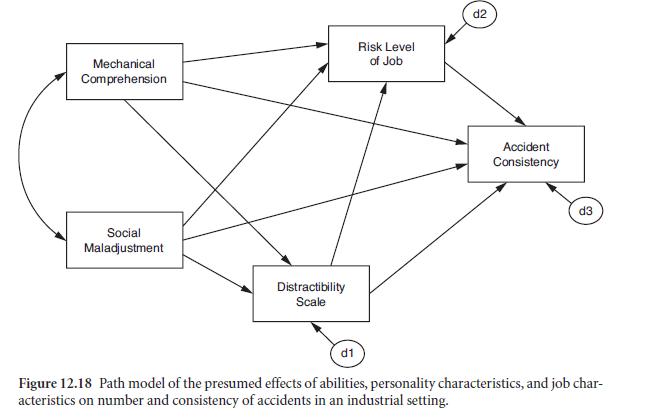7. Curtis Hansen tested a path model of the influences on accidents among chemical industry workers (1989).
Question:
7. Curtis Hansen tested a path model of the influences on accidents among chemical industry workers (1989). A simulated version of a portion of the data are on the website
(www.tzkeith.com) under Chapter 12 (e.g., “Hansen accident data.sav”; the file is also available in other formats). A guiding question for our analysis might be: what are the

relative effects of abilities, personality characteristics, and job characteristics on workers’
accident rates? Figure 12.18 shows a model designed to answer this question.
Mechanical Comprehension (Mechanic in the data file) was a measure of workers’
understanding of mechanical reasoning. Social Maladjustment (Maladjust) was a 50-item scale derived from the MMPI and designed (by Hansen) to assess general social maladjustment. These two variables are exogenous variables in the model. The Distractibility Scale (Distractibility), also derived from the MMPI, was designed to assess distractibility, and especially “neurotic-anxious” (Hansen, 1989, p. 83) characteristics that should lead to distractibility. The Risk Level of the Job (Risk) was a rating of the “responsibility and accident potential” (Hansen, p. 84) of each possible job on a 1 to 35 scale. The final endogenous outcome variable was Accident Consistency (Accident), a measure of the number of accidents for a worker plus the number of years in which each worker had an accident.
Estimate the model shown in the figure using multiple regression analysis. What is the identification status of the model? Calculate the direct effects and disturbances and put them in your model. Calculate total effects on Accident Consistency and create a table of direct, indirect, and total effects. Interpret the results. What were the important effects on accident consistency? Were there meaningful indirect effects? If so, interpret them. Which variable(s) had the strongest total effect on accident consistency?
Step by Step Answer:







